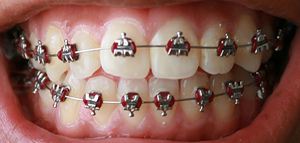Orthodontic archwire
Orthodontic Archwire[edit | edit source]
An orthodontic archwire is a wire used in orthodontics to align and straighten teeth and help to position them properly in relation to a person's bite, while also working to improve dental health. It is a critical component of dental braces, which are used to correct malocclusions, such as overbite, underbite, crossbite, and open bite.
Composition[edit | edit source]
Orthodontic archwires are made from various materials, each offering different properties. Common materials include:
- Stainless steel: Known for its strength and durability, stainless steel is a traditional choice for archwires.
- Nickel-titanium (NiTi): This material is known for its shape memory and superelasticity, making it ideal for initial alignment.
- Beta-titanium: Offers a balance between flexibility and strength, providing more control over tooth movement.
- Cobalt-chromium: Allows for customization of stiffness and is used in specific clinical situations.
Types of Archwires[edit | edit source]
Orthodontic archwires come in various types, each serving a specific purpose in the treatment process:
- Round wires: Typically used in the initial stages of treatment to level and align the teeth.
- Rectangular wires: Used in later stages to control the movement of the teeth more precisely.
- Square wires: Provide a combination of control and flexibility, used in intermediate stages.
Function[edit | edit source]
The primary function of an orthodontic archwire is to apply force to the teeth, guiding them into the desired position. The wire is threaded through brackets attached to each tooth and is secured with ligatures. As the wire attempts to return to its original shape, it exerts pressure on the teeth, encouraging movement.
Adjustments[edit | edit source]
Throughout the course of orthodontic treatment, archwires are periodically adjusted or replaced to continue the movement of the teeth. Adjustments may involve changing the wire's shape, size, or material to achieve the desired outcome.
Related Pages[edit | edit source]
Search WikiMD
Ad.Tired of being Overweight? Try W8MD's physician weight loss program.
Semaglutide (Ozempic / Wegovy and Tirzepatide (Mounjaro / Zepbound) available.
Advertise on WikiMD
|
WikiMD's Wellness Encyclopedia |
| Let Food Be Thy Medicine Medicine Thy Food - Hippocrates |
Translate this page: - East Asian
中文,
日本,
한국어,
South Asian
हिन्दी,
தமிழ்,
తెలుగు,
Urdu,
ಕನ್ನಡ,
Southeast Asian
Indonesian,
Vietnamese,
Thai,
မြန်မာဘာသာ,
বাংলা
European
español,
Deutsch,
français,
Greek,
português do Brasil,
polski,
română,
русский,
Nederlands,
norsk,
svenska,
suomi,
Italian
Middle Eastern & African
عربى,
Turkish,
Persian,
Hebrew,
Afrikaans,
isiZulu,
Kiswahili,
Other
Bulgarian,
Hungarian,
Czech,
Swedish,
മലയാളം,
मराठी,
ਪੰਜਾਬੀ,
ગુજરાતી,
Portuguese,
Ukrainian
Medical Disclaimer: WikiMD is not a substitute for professional medical advice. The information on WikiMD is provided as an information resource only, may be incorrect, outdated or misleading, and is not to be used or relied on for any diagnostic or treatment purposes. Please consult your health care provider before making any healthcare decisions or for guidance about a specific medical condition. WikiMD expressly disclaims responsibility, and shall have no liability, for any damages, loss, injury, or liability whatsoever suffered as a result of your reliance on the information contained in this site. By visiting this site you agree to the foregoing terms and conditions, which may from time to time be changed or supplemented by WikiMD. If you do not agree to the foregoing terms and conditions, you should not enter or use this site. See full disclaimer.
Credits:Most images are courtesy of Wikimedia commons, and templates, categories Wikipedia, licensed under CC BY SA or similar.
Contributors: Prab R. Tumpati, MD

